Samsung QE75QN900A Review: A cutting edge TV
Verdict
By calculation new mini-LED lighting and nearly 2000 dimming zones to an 8K resolution, Samsung's already impressive backlighting and QLED technologies serve upwards arguably the almost cutting-border TV we've ever seen.
Pros
- Sensational HDR picture quality
- Splendid gaming features and operation
- Spectacular design
Cons
- Difficult on the bank residuum
- Native 8K content remains elusive
- Aggressive dimming of very minor bright objects
Central Features
- Native 8K resolution The screen carries 4 times as many pixels as a 4K panel
- Mini-LED backlighting Uses smaller LEDs behind the screen to requite control over calorie-free
- Eden Smart organisation Samsung'due south proprietary smart arrangement
- Object Tracking Sound Speakers around each edge of the screen combine to brand sound effects appear to be coming from exactly the right place on the screen
- 4K/120Hz, VRR and ALLM The latest gaming features are all covered by the 75QN900A'due south HDMI ports
Introduction
We've already been treated recently to a spectacular demonstration of what the LCD TV world's new mini-LED engineering tin do in the shape of Samsung's flagship 4K Television set for 2021, the 65QN95A.
However, it turns out that this was merely the commencement of Samsung's mini-LED ambitions. Sat imposingly on our test benches is a 75-inch Samsung TV, the 75QN900A, which combines an 8K resolution with mini-LED lighting. It's backed up by more twice as many separate backlight dimming zones as featured on the 65QN95A – and the results are jaw-dropping.
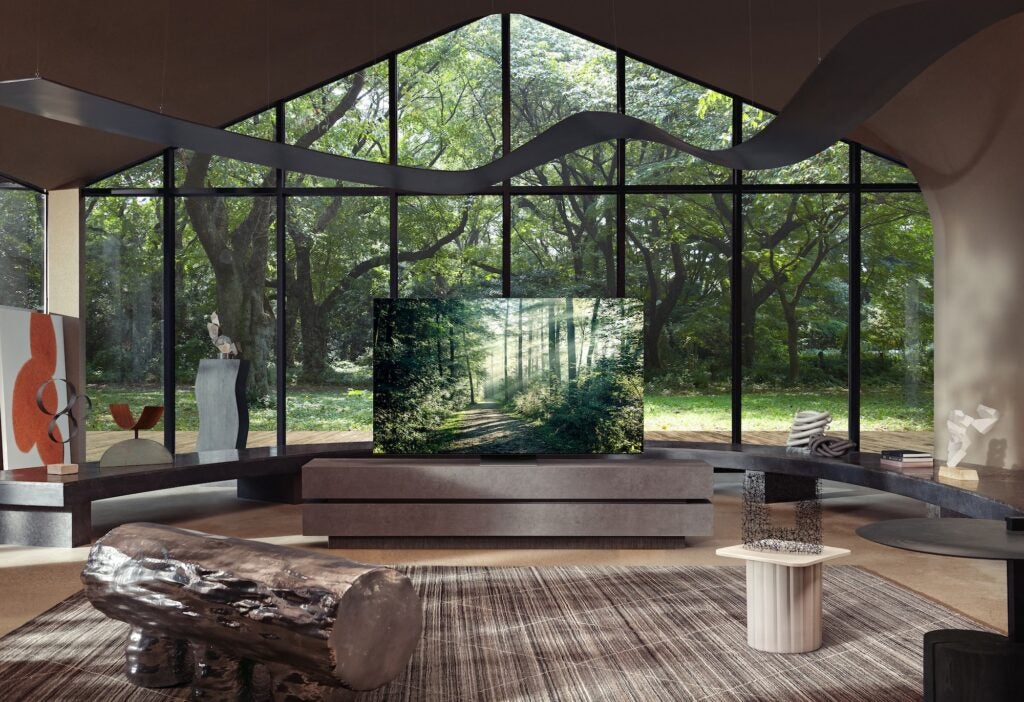
Availability
- UK RRP: £6999
- USA RRP: $5799.99
- Europe RRP: €7499
- Canada RRP: CA$9499.99
At £6999, the QE75QN900A will put a rather large hole in your wallet. To put it in perspective, you tin can get LG'southward 77-inch 4K OLED77C1 TV for only £3999 at the time of writing.
Inevitably, this puts a lot of pressure on the ability of the Samsung set's mini-LED technology to have picture quality to some other level by combining the loftier brightness for which LCD known, with the sort of local contrast of OLED applied science.
Likewise, it'southward worth adding that LG's latest 77-inch 8K OLED Telly will fix you lot back a absurd 12 grand.
In the U.s.a., the equivalent QN75QN900A is available at the time of writing (following a recent reduction from $6999) for just $5799. That makes the Great britain price await like it could do with a reduction, as well.
Pattern
- Bezel-free 'Infinity' blueprint
- 4 HDMI two.1 ports
- Innovative Object Tracking Audio speaker system
Never listen £6999; the QE75QN900A looks a million dollars. Particularly amazing to behold is the manner information technology supports its mammoth 75-inch screen in… well, seemingly nix. The bezel is and then slim when you're looking at the screen head-on that you tin can barely run across it.
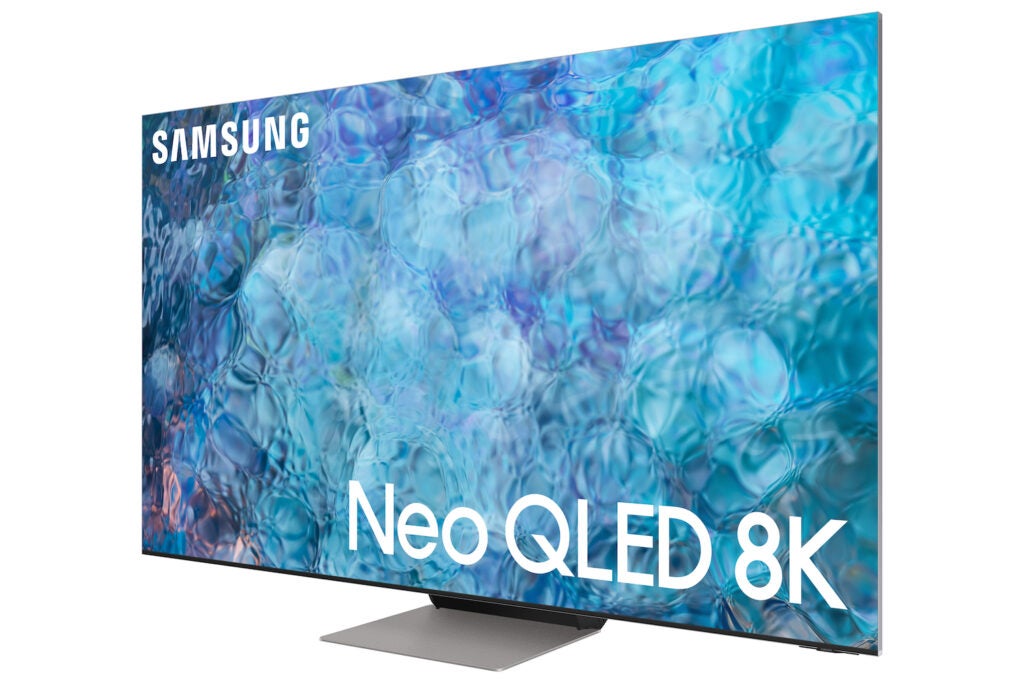
Samsung'south 2021 flagship is likewise markedly slimmer circular the back than its 2020 predecessor, enhancing the 'pictures from nowhere' trick.
What chassis at that place is, though, is seriously pretty. The whole thing is wrapped in a gleaming metallic end, with an bonny perforated edge to each side console reminding u.s.a. that, unusually, the 75QN900A carries speakers tucked inside. More on this later.
The huge screen sits on a surprisingly narrow, centrally mounted desktop stand, if you're not wall-hanging it. This stand is supremely well built, and doesn't at all feel like information technology will have any trouble handling the weight and size of the screen attached to it, despite how narrow it is.
The 75QN900A's gorgeous minimalist pattern is completed by its total freedom from ugly cablevision spaghetti, thanks to an external 1 Connect box that can really adhere invisibly to the angled rear of the desktop stand. Even if you'd rather have the I Connect sat to the side of the TV for easier access, yous'll still only require a single cable to attach it to the screen.
Features
- Native 8K resolution
- Mini-LED technology with local dimming
- Object Tracking Sound organisation
Fittingly for a £6999 flagship Television, the 75QN900A is rammed with seriously cutting-edge features. Starting with the small-scale thing of its '8K' 7680 10 4320 pixel count.
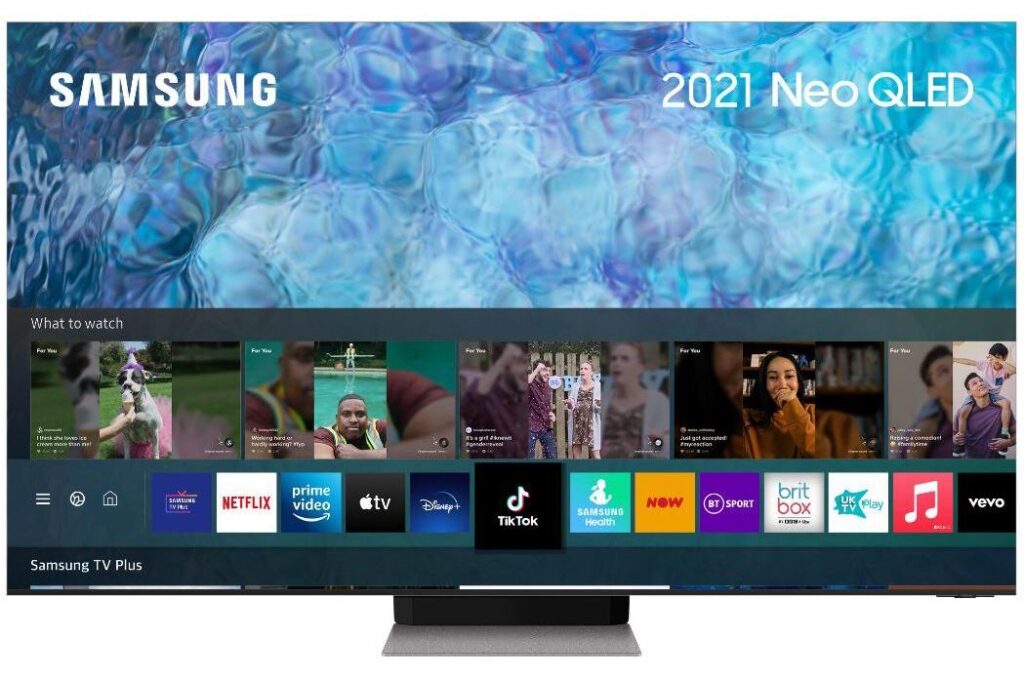
This fills the screen with four times every bit many pixels as a 4K Boob tube. Cynics may question the point of this when the only native 8K source currently available in the consumer world is a minor drove of YouTube videos.
However, we've already seen with previous generations of 8K TV from Samsung and others that the quality of upscaling processing nowadays – specially when backed up by 'AI' equally it is on the QE75QN900A – can lead to 4K and even HD images looking better on an 8K screen. This is peculiarly truthful when it comes to dots per inch density.
Samsung has really greatly enhanced the power of its 2021 flagship AI upscaling system. Previously, the processing analysis and results Samsung's 8K upscaling relied upon were fatigued from the efforts of a single neural network. For the 75QN900A, however, the AI system has drawn its processing know-how from the combined assay work of no less than sixteen different neural networks.
Of course, there remains an outside shot that native 8K content will eventually start to appear in volume. And if/when that happens, only people with an 8K TV such as the QE75QN900A will exist in a position to take reward of it.
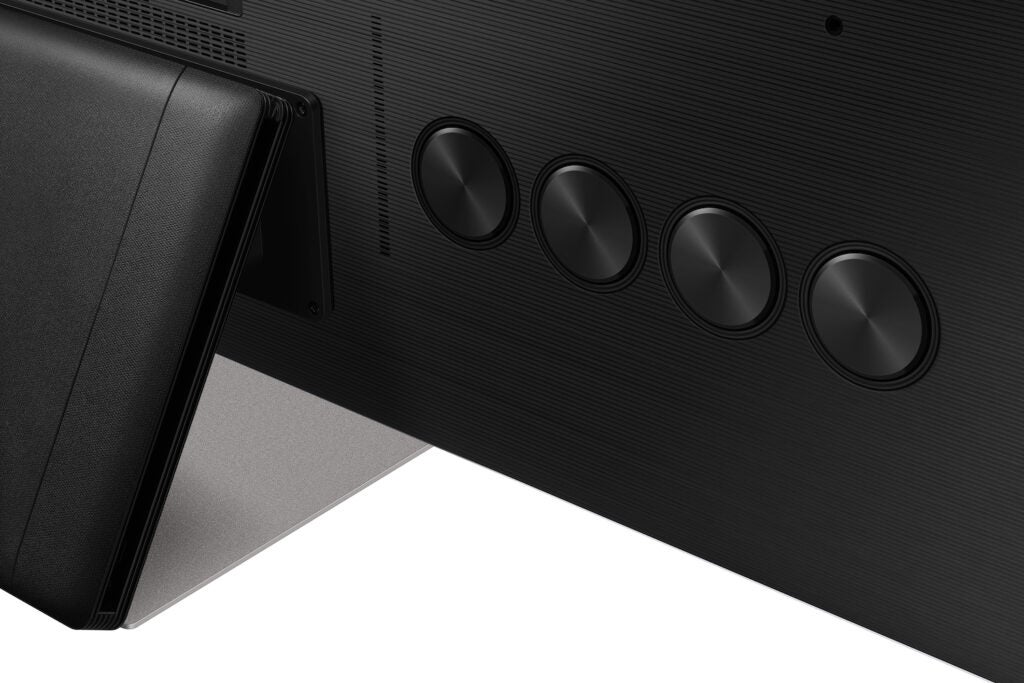
The 75QN900A's adoption of mini-LED engineering is arguably its most significant feature. This sees Samsung remove the lens and packaging that bulks upwardly normal LEDs to fit many more smaller LEDs into the same screen space.
Samsung has then backed up this boost in LED numbers with an increment in the number of separately controlled dimming zones. The 4K 65QN95A upped the dimming zone count from around 480 to 792 on its non-mini LED processor. With the 75QN900A, though, Samsung goes dimming crazy with 1920 zones of LEDs able to output different amounts of light at any given moment.
Fans of OLED will be keen to point out that every single pixel in an OLED screen tin can deliver its ain singled-out calorie-free output. The big thing nigh the 75QN900A, though, is that it combines its vastly improved local low-cal control with levels of effulgence with which OLED tin't compete.
In fact, in its Dynamic motion-picture show preset the 75QN900A can fleetingly pump out a massive 4000 nits of brightness. This really does only last for a brief moment before the screen dims down to well under half that effulgence, but information technology's possible yous really might momentarily see this sort of intensity in real-world content, where a seriously vivid highlight only appears on-screen for an instant.
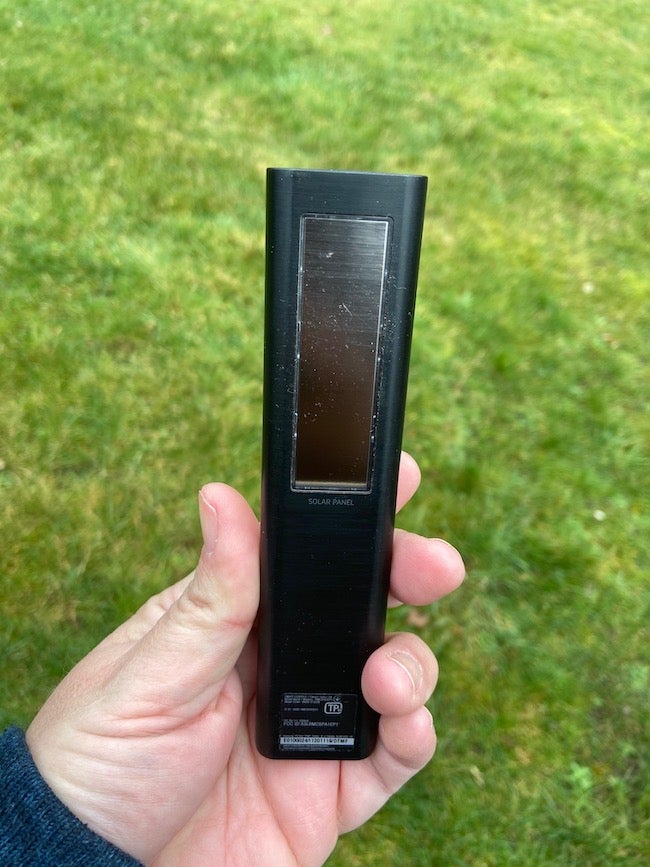
Fifty-fifty the more 'stable' Standard motion picture preset continues to deliver a sustained 1680 nits of light when measured on a white HDR window occupying x% of an otherwise black screen. This is pretty much double the peak brightness that standard OLED technology tin can provide, and still the best function of 700 nits more even the new generation of 'high brightness' OLED panels.
Regular readers will know that Samsung has hit 2000 nits or and so of brightness in the by without mini-LED technology. The cardinal point about mini-LED, though, is the ability information technology offers – in conjunction with the boost in the number of local dimming zones – to evangelize loftier effulgence without the sort of backlight 'blooming' around brilliant objects that's usually such a headache for very bright LCD TVs.
All this brightness needs to be partnered with an advanced colour organisation if information technology isn't going to bleach out colours. Cue QLED: the proper noun now given to TVs that use quantum dot rather than color filter technology to produce their colours. The quantum dot approach enables more precise colour tones to be produced beyond a wider colour volume. Peculiarly when, equally in the 75QN900A'due south example, the QDs are encased in a metal shell so they can be driven harder.
As with Samsung'south previous few flagship LCD TV generations, the 75QN900A features wide viewing angle technology so that people who aren't watching the TV from head-on don't come across as much color and dissimilarity reduction as they would with regular LCD TVs.
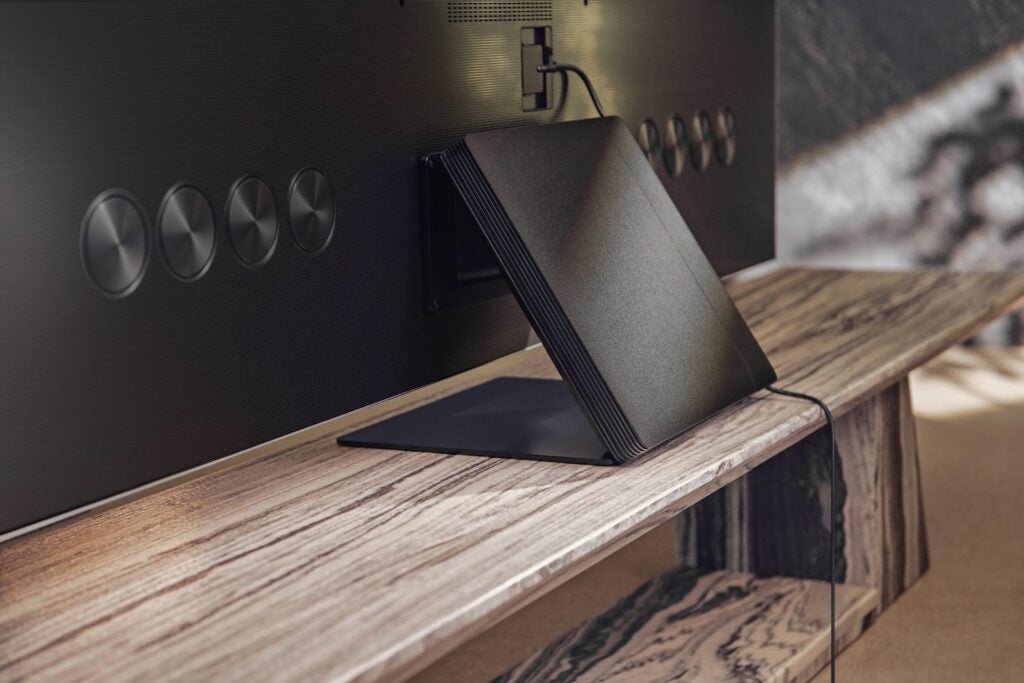
The 75QN900A'due south connectivity is outstanding – chiefly considering all four of its HDMIs are built to the latest HDMI 2.1 standard, with 40Gbps support. This means that all iv can back up cut-edge gaming features – 4K at 120Hz, variable refresh rates and automatic low latency style (ALLM) switching – introduced by the Xbox Series X and PS5 consoles, as well equally the latest premium AMD and Nvidia PC cards.
In fact, the QE75QN900A can likewise support the AMD FreeSync Pro and Nvidia G-Sync variable refresh charge per unit systems – although the latter is not officially supported.
When set to Game mode, the Samsung 75QN900A also gets the time it takes to reproduce game prototype data received at its inputs down to only nether 10ms. Which is remarkably fast for any Television, never mind one that'southward having to add tens of millions of pixels to even 4K sources.
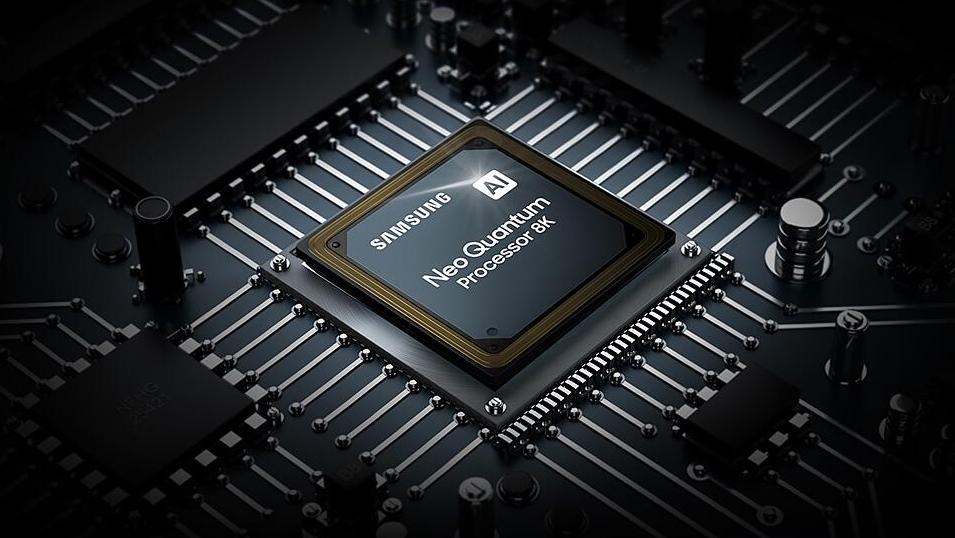
Samsung has introduced a new Game Bar, too, which handily provides an at-a-glance guide to the incoming graphics format and TV settings you're using for your current gaming session.
The but glitch in the 75QN900A's connectivity matrix comes with its HDR support. For while information technology supports HDR10 (as all HDR TVs must), the HLG live broadcast/stream HDR format, and the agile HDR10+ format, information technology doesn't cover the Dolby Vision format. This, like HDR10+, adds extra scene-past-scene image data, and is found on more than sources than HDR10+. Including, now, the Xbox Series X, for both gaming and streaming services.
Finally, smart services are provided by Samsung'south Tizen-based Eden system. This is a strong attempt in terms of both the range of apps it covers and its presentation. This helpfully uses content 'shelves' superimposed over the bottom of the image rather than a full-screen interface for its homescreen, and navigation is like shooting fish in a barrel to follow. There are plenty of customisation options, too.
The only flaw is the lack of either Freeview Play or YouView apps for bringing all the take hold of-upward services for the central UK terrestrial broadcasters nether one umbrella app. All those UK catch-up apps are there in their private forms, however.
Pic quality
- Loftier peak effulgence
- Bright image that also delivers deep black levels
- AI 8K upscaling technology
While we were impressed by the difference mini-LED technology made to the 65QN95A, we've had our tiny minds diddled by the difference it makes on the 75QN900A.
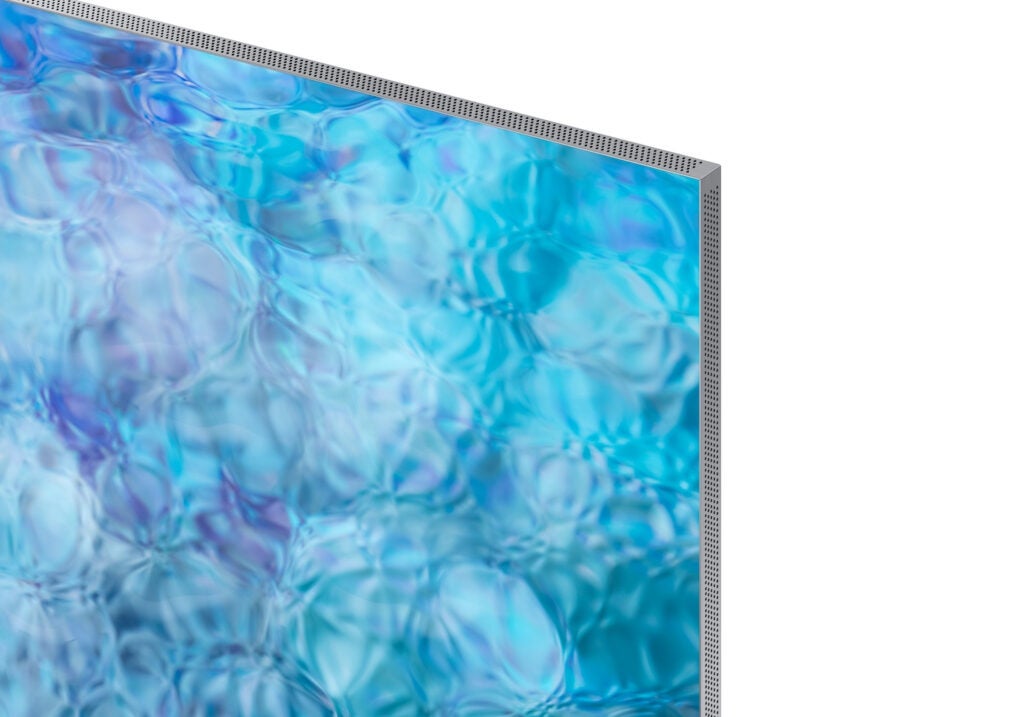
The massive increment in dimming zones is transformational. Dark scenes benefit from stunning black levels by LCD TV standards. They get so deep, in fact, that fifty-fifty in a blacked-out room you can oft feel like you're watching an OLED Boob tube, not an LCD.
Except, that is, that the 75QN900A is capable of producing levels of brightness that no OLED TV can. Bright HDR imagery explodes off the screen, hitting with an impact that not simply makes SDR expect dead and buried, simply also captures that 'real life' feeling that HDR is truly all about.
The 75QN900A noticeably improves on the colour functioning of its predecessor, likewise, delivering a richer, more vibrant palette that keeps upward with the screen'south brightness, rather than starting to expect a little faded in the brightest areas.
The issue is an eye-popping demonstration of what wide color gamut in conjunction with HDR technology tin do. Especially given that the 75QN900A'south new lighting engine means there's far less chance than there has been on whatever previous Samsung Television receiver for images that contain a mix of light and night content to suffer with either backlight blooming/clouding, or extreme local dimming. Both of which can have an impact on color tones.
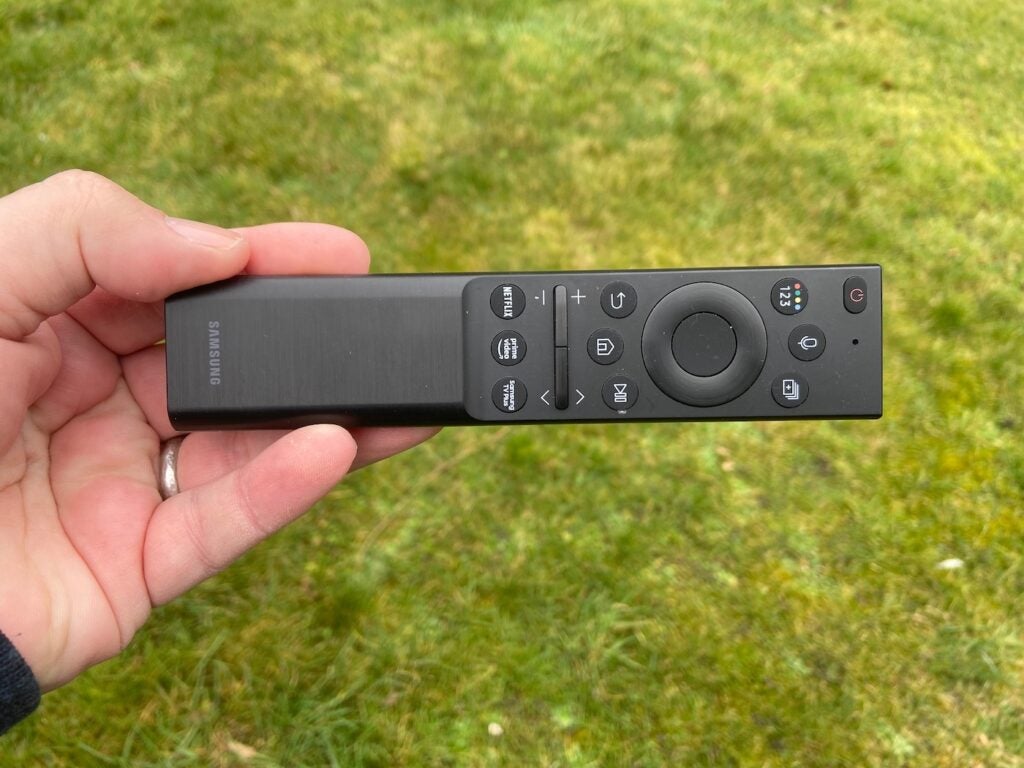
The 75QN900A'due south mini-LED lighting and dimming arrangement also tackles what has consistently been the biggest weakness of Samsung's premium TVs. Previously, while Samsung has pretty much ruled the earth when information technology comes to the depth and consistency of the black colours that premium LCD TVs can reproduce, it has had to severely dim down areas of brightness that stand out confronting very dark backgrounds.
Otherwise, they'd accept caused pretty glaring light 'halos' effectually them. All the same, the combination of mini-LED lighting with nearly 2000 dimming zones means that all merely the tiniest areas of peak brightness can retain virtually full, uncompromised brightness – even when they appear against almost full blackness.
Samsung's native 8K pictures await dazzlingly abrupt, dumbo and textured, as well as enjoying an actress sense of 3 dimensionality and realism. Some will tell you that native 8K resolutions don't matter until you go to really huge screens of most 90 inches and more, but the departure at 75 inches seems articulate to me – fifty-fifty if it makes its presence felt in more subtle means than mere 'sharpness'.
Arguably more than importantly, given the lack of 8K content, the 75QN900A's upscaling noticeably improves over the already excellent efforts of Samsung's 2020 8K sets. Upscaled 4K sources wait even cleaner and sharper, as well as containing a greater sense of depth than the same sources enjoy on most native 4K TVs.
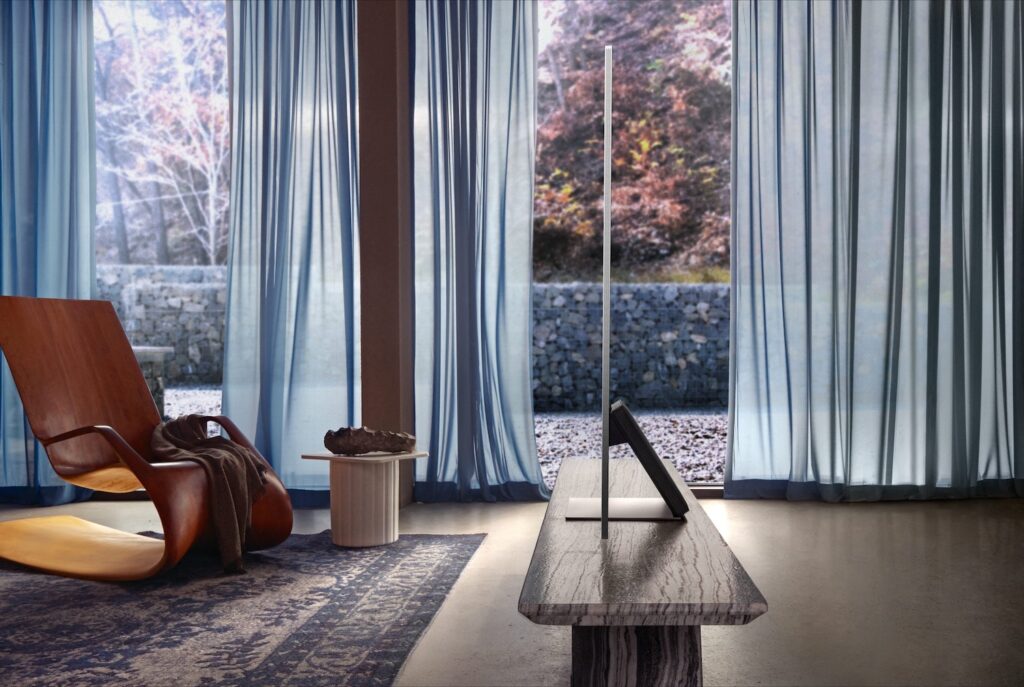
The input of all the actress neural networks Samsung has deployed in developing its 2021 AI processing has fifty-fifty more bear upon on upscaled HD sources, which expect both far sharper and far cleaner (less affected by source noise) than they did on last year's 8K models. The results are never less than watchable, even with heavily compressed digital sources, and tin can even look genuinely enjoyable with adept-quality Hard disk drive sources.
The sharpness holds up well during camera pans and over fast-moving objects, too. Only make sure that you don't stick with the 75QN900A'southward default Auto Picture Clarity settings, however. The motion processing in this Auto mode is too heavy-handed, causing lots of digital side effects that are actually far more distracting than a chip of judder. Cull the Custom motion setting and judder and blur values of around three or four to become the almost natural results.
The 75QN900A doesn't just dazzle with movie and TV content. It's also a formidable gaming display. Native 4K and 120Hz titles expect pivot-abrupt and effortlessly shine. The screen handles variable refresh rates immaculately across all the electric current VRR formats, and lag is so low it's essentially insignificant. The ALLM switching works perfectly with the Xbox Series X, too.
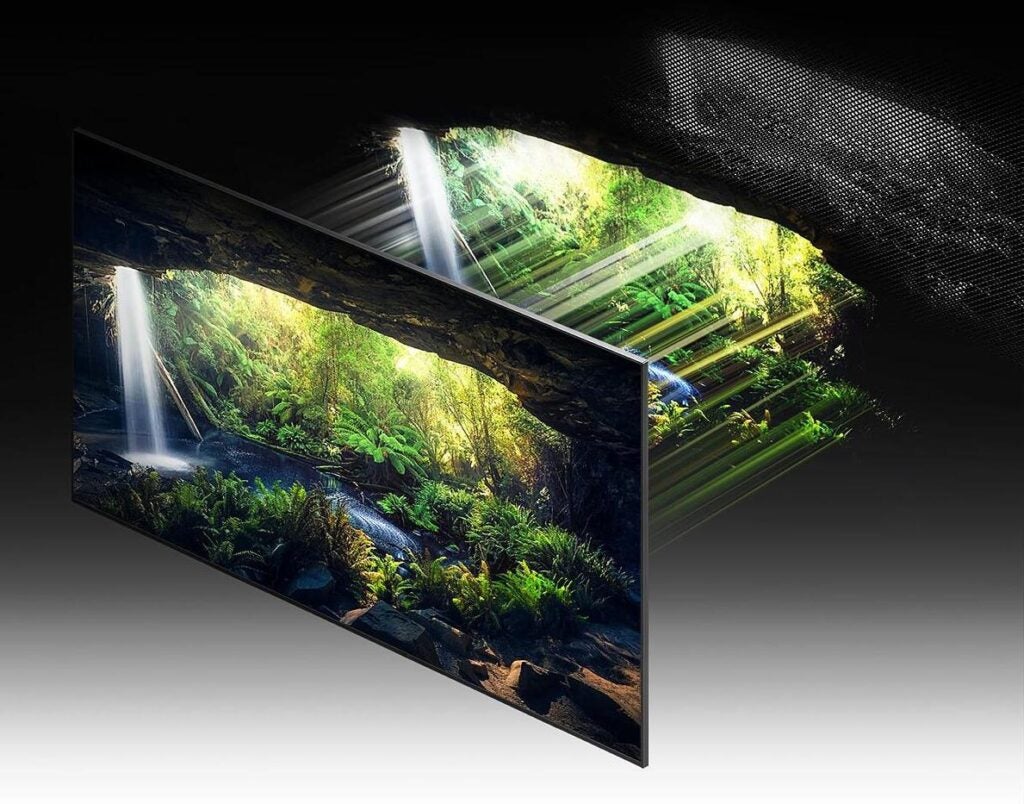
separate dimming zones.
Its big bound in dimming zones means the 75QN900A doesn't suffer as much – or at all, really – with backlight blooming/haloing when gaming equally the 65QN95A. Plus, its brightness adds a gorgeous actress sense of realism to potent HDR titles such as Phone call Of Duty Black Ops: Cold War.
Equally noted with the 65QN95A, for me, the default FreeSync Pro settings don't get the best out of the 75QN900A's pictures. Nevertheless, information technology's easy enough to tweak the colour and backlight settings without losing FreeSync Pro's VRR talents.
While the 75QN900A'southward pictures are for the most office footing-breakingly stellar, they aren't quite perfect. In particular, while the mini-LED lighting and generous number of dimming zones has had a pregnant touch on the TV'south consistent handling of bright highlights, there's nonetheless a size factor in play. So where a bright highlight is really pocket-sized, the Tv set still has to reduce its intensity quite substantially to proceed backlight blooming at bay. This is a rare reminder that even virtually 2000 dimming zones isn't the same as the pixel-level lighting of OLED technology.
Next, while backlight blooming is virtually a not-issue when viewing the 75QN900A directly on, information technology tin start to rear its head when you're viewing from an angle.
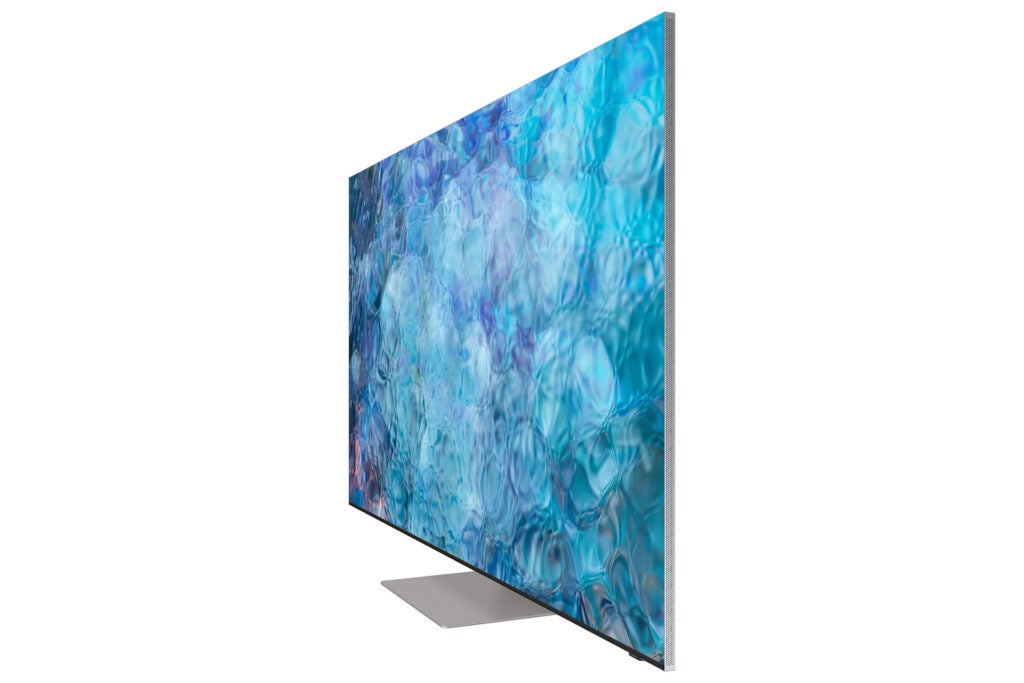
Rich reds can take on a pink tone from fourth dimension to fourth dimension, too, and while the Standard picture preset generally delivers the most satisfying and exciting results overall, it can beat a piddling shadow detail out of very dark scenes.
Given how stellar the 75QN900A looks with HDR, nosotros tin can't aid but wish we were able to see how information technology might handle the Dolby Vision format – although Samsung's ain dynamic tone mapping is undeniably impressive.
Ovreall, though, none of the niggles prevent the 75QN900A from being a dazzling exhibition of where Tv picture show quality is at in 2021.
Sound quality
- Wide sound phase
- Clear dialogue
- Speakers could be a little louder
While the 75QN900A's audio organization is clever, it isn't every bit out-there astonishing equally its pictures. Some aspects piece of work very well; the manner the OTS+ organization places sound in the correct part of the screen – even tracking moving objects – is remarkable, instantly making the sound more compelling and immersive.
The big number of speakers likewise creates a super-wide sound stage, casting sound well beyond the confines of the Telly'south super-skinny frame in all directions. And it does this without whatever elements of the sound condign baggy or confused.
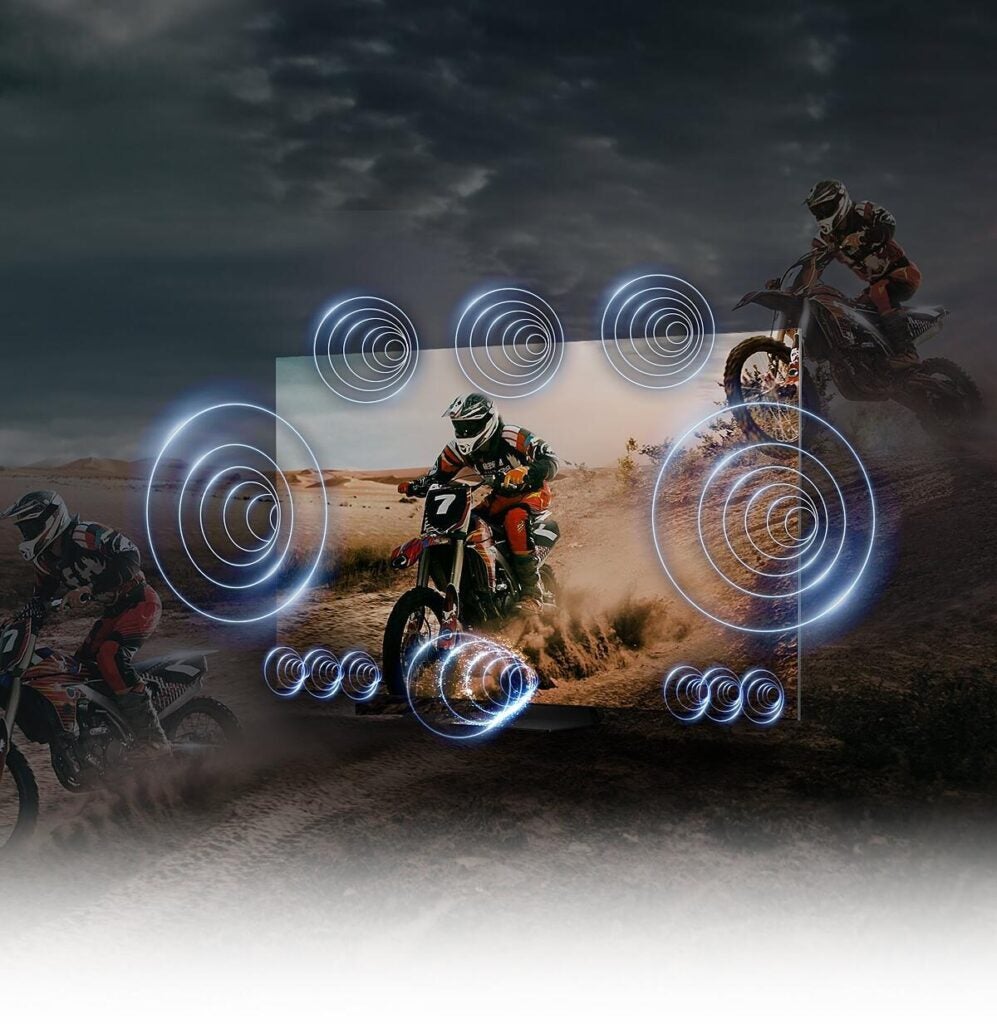
Dialogue is consistently articulate and has its on-screen positioning bolstered past the OTS+ Surround system, likewise.
Surprisingly, considering the number of drivers information technology carries – in that location's even a formidable roster of eight mid-range/low-frequency drivers facing out from the 75QN900A'due south rear to get with the speakers built into the set's barely there frame – Samsung'due south 8K set doesn't deliver specially deep or powerful bass. In addition, the sound struggles to project forward into your room, frequently leaving the audio stage feeling equally if it's behind the TV rather than in front of it.
Neither do the 75QN900A'southward speakers become quite as loud equally you might promise for in a TV with such big, cinematic pictures. These various issues add up to a dynamic range that sometimes feels hemmed in versus the best sounding TVs out there.
I should stress that the 75QN900A's audio is yet skillful by the standards of the TV world at large, even so. Information technology's worth mentioning, too, that thanks to Samsung's Q Symphony feature, you can partner the TV'southward speakers with a compatible Samsung soundbar to surprisingly good effect.
Should y'all buy it?
Yous want the most spectacular HDR pictures around The 75QN900A's combination of mini-LED lighting, QLED colour and farthermost local dimming help it get massive impact from today's HDR movie technology.
You're not feeling flush or you really want Dolby Vision At the best part of £7K, the 75QN900A will simply exist beyond the upkeep of many buyers. And it's a shame Samsung still doesn't support the Dolby Vision HDR format.
Final Thoughts
If you're financially able to encounter past the 75QN900A'southward hefty toll of entry, Samsung's latest flagship 75-inch TV sets the pulse racing from the off with its stellar build quality and spectacular borderless design. And things only get better once y'all switch information technology on.
You lot might like…
How nosotros examination
We test every TV we review thoroughly over an extended period of time. We use manufacture standard tests to compare features properly. Nosotros'll always tell y'all what we detect. We never, ever, accept money to review a product.
FAQs
What sort of LCD technology does the Samsung 75QN900A utilise?
It uses new mini-LED lighting, backed upward past QLED colour applied science and 1920 separately controllable local dimming zones.
What native resolution is the Samsung 75QN900A's screen?
This is an 8K Idiot box, meaning it has 7680 x 4320 pixels (iv times equally many as a 4K Tv set).
What is the Samsung 75QN900A's One Connect box for?
Samsung has placed the connections on an external box that connects to the Television set via a single cablevision, to reduce the amount of cabling yous have to attach straight to the TV. You tin can besides adhere the Ane Connect to the neck of the Goggle box'due south desktop stand, so information technology becomes invisible too.
What cutting-border gaming features can the Samsung 75QN900A support?
4K at 120Hz, variable refresh rates using the AMD FreeSync Pro, Nvidia G-Sync and standard HDMI varieties, plus ALLM (automated depression latency mode) switching.
Specs
‹
UK RRP
U.s. RRP
Eu RRP
CA RRP
Manufacturer
Screen Size
Size (Dimensions)
Size (Dimensions without stand)
Weight
Release Date
Model Number
Model Variants
Resolution
HDR
Types of HDR
Refresh Rate TVs
HDMI (2.ane)
Audio (Power output)
Connectivity
Colours
Brandish Technology
›
Jargon buster
8K TV
8K refers to the resolution of a TV'due south display, which equates to the number of horizontal and vertical pixels it can display. With 8K, there's a total resolution of 7680 pixels horizontally and 4320 pixels vertically – four times that of 4K (3840 x 2160) and sixteen times that of Full HD (1920 x 1080). That'due south a jump from the 8.3 1000000 of pixels in 4K to effectually 33 meg pixels.
Bluetooth
Bluetooth - named after 10th-century Danish king Harald Bluetooth who united Denmark'due south tribes into a single kingdom - is a method of wireless manual that allows for the exchange of data between devices over short distances.
FALD
FALD stands for Full Array Local Dimming and is a more advanced version of Local Dimming technology. Information technology divides a TV'southward screen into zones where contrast/black levels can exist controlled. In theory, the more than zones there are, the more control over black levels and contrast at that place tin can be, resulting in a more dynamic looking moving picture.
Filmmaker Mode
Filmmaker Manner is a picture mode supported past some TV manufacturers that disables post-processing features (eastward.g. motility smoothing), and preserves the correct attribute ratios, colours and frame rates that respects the original writer's creative intent.
eARC
eARC (Enhanced Audio Return Aqueduct) is the update to ARC and it boosts the bandwidth and speed, making room for object-based audio surround formats such as DTS:X and Dolby Atmos to be sent directly to an AV receiver/soundbar.
QLED
QLED stands for Quantum-dot Light Emitting Diode. It's a display applied science that uses pocket-size particles (called Quantum Dots) fabricated up of slightly different sizes that produce different wavelengths (colours) when calorie-free is shone through them. This filter helps to emit a brighter and wider gamut of colours than a conventional LED Goggle box is capable of.
Source: https://www.trustedreviews.com/reviews/samsung-qe75qn900a
Posted by: reedalind1967.blogspot.com


0 Response to "Samsung QE75QN900A Review: A cutting edge TV"
Post a Comment